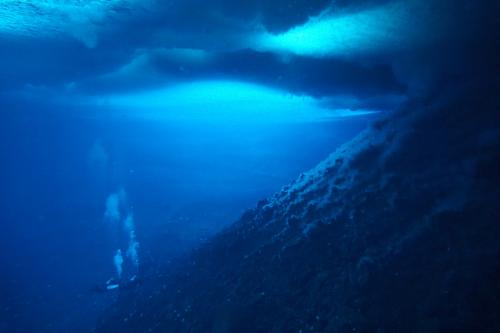 Dr. Art Woods and Dr. Amy Moran dive at the lower edge of the McMurdo Jetty. Visibility under the ice is nearly unlimited.
Dr. Art Woods and Dr. Amy Moran dive at the lower edge of the McMurdo Jetty. Visibility under the ice is nearly unlimited.
The bluish-grey ice slips by remarkably quickly and before I know it, I find myself in what I can only describe as a deep blue twilight world somewhere between slumber and waking. I hold myself against the underside of the frozen ceiling to get my bearings. I'm breathing rapidly, but not because the water is so cold; I'm excited because I can see forEVER. One storey below me, Steve touches his fingertips to the top of his head, a hand signal asking me if I'm ok. I am far more than ok. I am ecstatic. I am a hawk soaring high above a grassland. I am kite in the wind over a sun-kissed beach. In one direction, I can see rolling fields of attached invertebrate animals. In another direction, the rockslide-like jetty slopes upwards to meet the sea ice. Below me, I can see the other group of divers 70ft/21m down. The clarity of the water, known in diver parlance as "visibility," is seemingly unlimited and the best I've ever experienced.
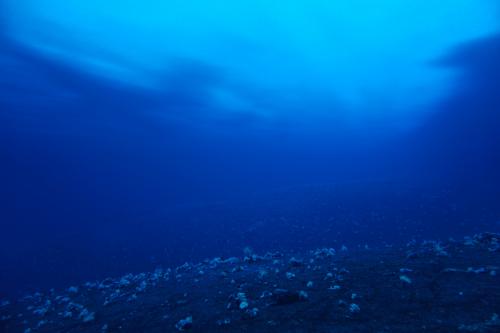 Everything in this photo that isn't ice or mud is an animal.
Everything in this photo that isn't ice or mud is an animal.
Once Steven Lane joins the group, we descend to 50ft/15m and begin buoyancy drills with Steve R. These drills let Steve R. know that Steve L. and Tim D. can manage the volume of air in our drysuits adequately enough to keep us from ascending or descending out of control. Once Steve is satisfied with Steve and me, he takes us on a low flying tour of the surrounding environs. I float above an astounding forest of invertebrates: pink soft corals, rope-like nemertean worms, snow-white barrel sponges, willow-shaped anemones, football-sized sea squirts, nudibranchs, isopods, sea stars, feather duster worms, and yes, sea spiders. Ever the scientist, Steve L. turns on his dive light and hunts for concentrations of these animals for collection on later dives. I stare into the osculum of a barrel sponge. The opening must be a meter across; the animal might be a thousand years old.
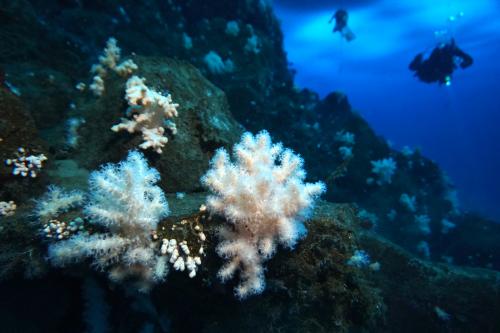 These soft corals feed on organisms drifting by on the currents, and, when disturbed, shrivel up to protect themselves.
These soft corals feed on organisms drifting by on the currents, and, when disturbed, shrivel up to protect themselves.
Twenty minutes into the dive, I'm feeling pretty cold, though I do not want this experience to end. Although completely dry, my hands, feet are not insulated enough to slow the loss of body heat and they begin to feel stiff and numb. Likewise my head and body are cool, and I begin to shiver intermittently. Plus, I'm running low on air. All are signs that it's time to go up. Steve, Steve, and I make our way back to the down line and ascend to a planned safety stop just below the bottom of the ice. For three more minutes, I hover far above the rockslide, admiring brine channels and anchor ice from a distance. Completing one final safety skill test, I unclip my backpack, detach my inflator hose and hold my tank in front of me as I swim up through the tube.
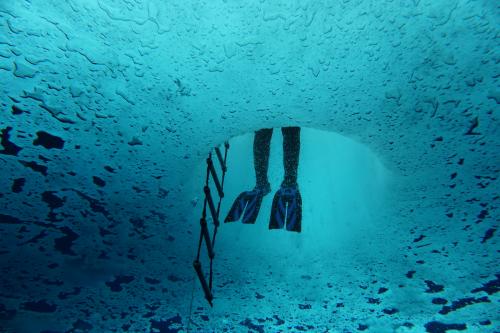 A diver enters the "tube" and eventually exits the water, aided by a rope ladder.
A diver enters the "tube" and eventually exits the water, aided by a rope ladder.
At the surface, Caitlin is waiting to take my tank and fins. I haul myself out using a rope ladder lowered into the hole and stand in the hut, still wearing my mask. "Well?" Rob asks. "How was it?" I am bodily cold and tired and when I go to speak, my numbed lips and mouth can only enthusiastically whisper "WOW!"
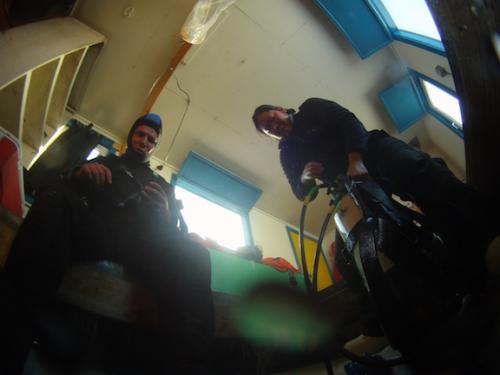 PhD Candidate Caitlin Shishido assists a diver in exiting the dive hole while PhD candidate Steve Lane prepares for a dive.
PhD Candidate Caitlin Shishido assists a diver in exiting the dive hole while PhD candidate Steve Lane prepares for a dive.

Comments